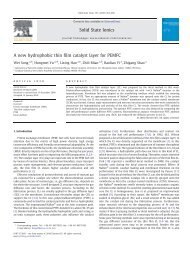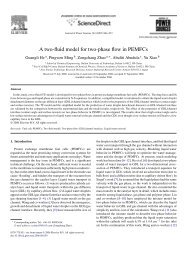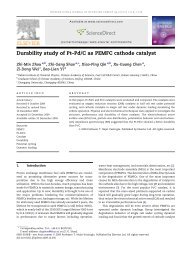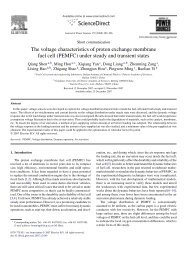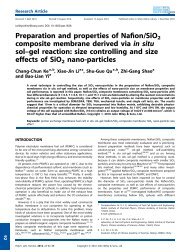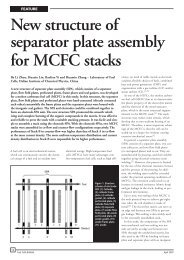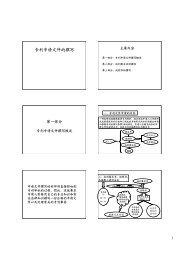Carbon-based films coated 316L stainless steel as bipolar plate for ...
Carbon-based films coated 316L stainless steel as bipolar plate for ...
Carbon-based films coated 316L stainless steel as bipolar plate for ...
Create successful ePaper yourself
Turn your PDF publications into a flip-book with our unique Google optimized e-Paper software.
406<br />
international journal of hydrogen energy 34 (2009) 405–409<br />
Fig. 1 – Diagram of the PBAIP experimental setup.<br />
a protecting film with good corrosion resistance and high<br />
interfacial conductivity on <strong>stainless</strong> <strong>steel</strong> through surface<br />
treatment is one of the possible solutions [6–10].<br />
Some researches have been conducted on <strong>for</strong>ming carbon<br />
material film on metal <strong>bipolar</strong> <strong>plate</strong>. This kind of <strong>bipolar</strong> <strong>plate</strong><br />
could combine the advantages of the two materials. Show<br />
et al. [11,12] <strong>coated</strong> amorphous carbon film on Ti <strong>bipolar</strong> <strong>plate</strong><br />
at various growth temperatures. They found that the <strong>bipolar</strong><br />
<strong>plate</strong> showed a low contact resistance when the growth<br />
temperature incre<strong>as</strong>ed up to 600 C, and the fuel cell <strong>as</strong>sembled<br />
with this kind of <strong>bipolar</strong> <strong>plate</strong> showed an output power of<br />
1.4 times higher than that <strong>as</strong>sembled with the bare Ti <strong>bipolar</strong><br />
<strong>plate</strong>s. Fukutsuka et al. [13] prepared carbon coating on<br />
SUS304 using pl<strong>as</strong>ma-<strong>as</strong>sisted chemical vapor deposition. The<br />
corrosion resistance of the <strong>bipolar</strong> <strong>plate</strong>s w<strong>as</strong> improved in<br />
simulated PEMFC conditions, and the interfacial contact<br />
resistance w<strong>as</strong> also greatly reduced. Similar study w<strong>as</strong> also<br />
conducted by Chung et al. [14]. In addition, some patents are<br />
also <strong>as</strong>sociated with the technology of metal b<strong>as</strong>e/carbon<br />
coating <strong>bipolar</strong> <strong>plate</strong>s [15–17].<br />
In our study <strong>316L</strong> <strong>stainless</strong> <strong>steel</strong> substrates were <strong>coated</strong><br />
with carbon-<strong>b<strong>as</strong>ed</strong> <strong>films</strong> by pulsed bi<strong>as</strong> arc ion plating (PBAIP)<br />
to obtain protecting layers. PBAIP inherits the advantages of<br />
arc ion plating and brings in new features such <strong>as</strong> reduced<br />
droplets, dense <strong>films</strong> and low-temperature deposition. As<br />
a result, <strong>films</strong> with excellent per<strong>for</strong>mance can most likely be<br />
obtained. What is more, <strong>for</strong>ming film by PBAIP is an environment-friendly<br />
process. Compared with the Cr–nitride <strong>films</strong><br />
<strong>for</strong>med by PBAIP in our previous work [10], deposition of the<br />
carbon-<strong>b<strong>as</strong>ed</strong> film can be greatly accelerated, which is<br />
appropriate <strong>for</strong> commercial production. This is because that<br />
the carbon source can be induced by the carbon target and not<br />
from the atmosphere. In addition, the economical price of the<br />
carbon target is helpful to lower the <strong>bipolar</strong> <strong>plate</strong> cost.<br />
2. Experimental<br />
The PBAIP system used in this study is shown in Fig. 1. The<br />
<strong>316L</strong> <strong>stainless</strong> <strong>steel</strong> substrates with size of<br />
100 mm 100 mm 0.1 mm were ultr<strong>as</strong>onically cleaned in<br />
acetone, ethyl ethanol and deionized water <strong>for</strong> 15 min. Then<br />
they were blown dry and put on holders. The chamber w<strong>as</strong><br />
evacuated to a b<strong>as</strong>e pressure below 5.0 10 3 Pa using a turbo<br />
molecular pump and a rotary pump. Prior to the deposition,<br />
the substrates were sputtered by Ar ions to remove the<br />
p<strong>as</strong>sive film on the <strong>stainless</strong> <strong>steel</strong> surface. Then the carbon<strong>b<strong>as</strong>ed</strong><br />
<strong>films</strong> were deposited with the two targets work<br />
synchronously. Three kinds of <strong>films</strong> were <strong>for</strong>med in our study<br />
(Table 1). When <strong>for</strong>ming the pure carbon film, two carbon<br />
targets were used in a vacuum. As <strong>for</strong> the carbon-<strong>b<strong>as</strong>ed</strong> <strong>films</strong>,<br />
a chromium target and a carbon target were used; the deposition<br />
processes were in a high vacuum and in a N 2 atmosphere,<br />
respectively.<br />
In our setup (Fig. 2) <strong>for</strong> me<strong>as</strong>uring the contact resistance,<br />
two pieces of Toray carbon paper were sandwiched between<br />
the <strong>bipolar</strong> <strong>plate</strong> sample and two copper <strong>plate</strong>s which are<br />
<strong>plate</strong>d with gold on both sides to enhance conductivity. An<br />
electrical current of 5.0 A, sourced by a PSP-2010 Programmable<br />
power supply, w<strong>as</strong> provided through the copper <strong>plate</strong>s.<br />
During the tests, the compacting <strong>for</strong>ce w<strong>as</strong> incre<strong>as</strong>ed with<br />
5Ns 1 controlled by a WDW Electromechanical Universal<br />
Testing Machine. All the samples (including the <strong>bipolar</strong> <strong>plate</strong><br />
samples and the carbon papers) were wafers with diameter of<br />
60 mm which is the same size <strong>as</strong> the copper <strong>plate</strong>s.<br />
X-ray photoelectron spectrometer (XPS) w<strong>as</strong> used to characterize<br />
the coating.<br />
The corrosion behaviors of the <strong>bipolar</strong> <strong>plate</strong> samples were<br />
investigated in simulated PEMFC environments (0.5 M<br />
H 2 SO 4 þ 5 ppm F ) by electrochemical tests. The experiments<br />
were per<strong>for</strong>med at 25 C to simulate the environment when<br />
the stack power w<strong>as</strong> off and at 70 C to simulate the environment<br />
when the stack power w<strong>as</strong> on. The corrosion solution<br />
w<strong>as</strong> bubbled thoroughly with either hydrogen g<strong>as</strong> (<strong>for</strong><br />
Table 1 – Technologies of <strong>for</strong>ming the carbon-<strong>b<strong>as</strong>ed</strong> <strong>films</strong><br />
with PBAIP.<br />
Film type<br />
Target<br />
material<br />
Flow rate<br />
of N 2 (sccm)<br />
C <strong>Carbon</strong> 0<br />
C–Cr <strong>Carbon</strong> and Cr 0<br />
C–Cr–N <strong>Carbon</strong> and Cr 20



